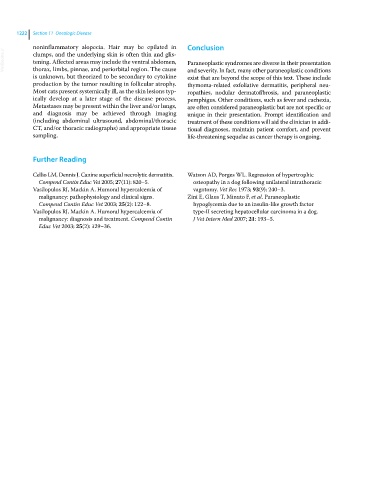Page 1284 - Clinical Small Animal Internal Medicine
P. 1284
1222 Section 11 Oncologic Disease
noninflammatory alopecia. Hair may be epilated in Conclusion
VetBooks.ir clumps, and the underlying skin is often thin and glis- Paraneoplastic syndromes are diverse in their presentation
tening. Affected areas may include the ventral abdomen,
thorax, limbs, pinnae, and periorbital region. The cause
is unknown, but theorized to be secondary to cytokine and severity. In fact, many other paraneoplastic conditions
exist that are beyond the scope of this text. These include
production by the tumor resulting in follicular atrophy. thymoma‐related exfoliative dermatitis, peripheral neu-
Most cats present systemically ill, as the skin lesions typ- ropathies, nodular dermatofibrosis, and paraneoplastic
ically develop at a later stage of the disease process. pemphigus. Other conditions, such as fever and cachexia,
Metastases may be present within the liver and/or lungs, are often considered paraneoplastic but are not specific or
and diagnosis may be achieved through imaging unique in their presentation. Prompt identification and
( including abdominal ultrasound, abdominal/thoracic treatment of these conditions will aid the clinician in addi-
CT, and/or thoracic radiographs) and appropriate tissue tional diagnoses, maintain patient comfort, and prevent
sampling. life‐threatening sequelae as cancer therapy is ongoing.
Further Reading
Cellio LM, Dennis J. Canine superficial necrolytic dermatitis. Watson AD, Porges WL. Regression of hypertrophic
Compend Contin Educ Vet 2005; 27(11): 820–5. osteopathy in a dog following unilateral intrathoracic
Vasilopulos RJ, Mackin A. Humoral hypercalcemia of vagotomy. Vet Rec 1973; 93(9): 240–3.
malignancy: pathophysiology and clinical signs. Zini E, Glaus T, Minuto F, et al. Paraneoplastic
Compend Contin Educ Vet 2003; 25(2): 122–8. hypoglycemia due to an insulin‐like growth factor
Vasilopulos RJ, Mackin A. Humoral hypercalcemia of type‐II secreting hepatocellular carcinoma in a dog.
malignancy: diagnosis and treatment. Compend Contin J Vet Intern Med 2007; 21: 193–5.
Educ Vet 2003; 25(2): 129–36.

